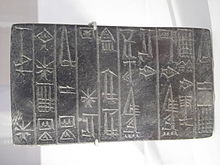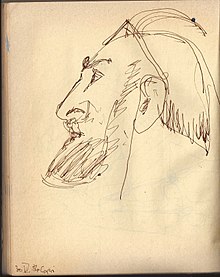Unique
Unikat (Latin: unus one, a single; adj. Unikal = unique, unique) denotes the uniqueness of an object, but not a person.
Demarcation and overlapping of terms
The terms individuality , unique and individual are used for people . The distinction between original and unique is complex. An original can be unique, but does not have to be. Example: In addition to other criteria, an etching is an original if it is hand-signed by the artist and the number of copies is limited. Only the signature gives the unique value of this work. In the jewelry sector, up to 12 versions of one model are still legally considered to be unique. A production number beyond that is referred to as a small series. A unique item can be an original, but does not have to be, if it is e.g. B. is a counterfeit art . Nevertheless, the forgery itself, if only carried out once, remains a unique specimen such as B. the Hitler diaries . The term height of creation deals with the delimitation from a copyright and legal point of view. Unique also means the only copy of a document . Opposites to unique are duplicates , series production and mass-produced goods .

Use of terms
art
The term unique is mainly used in the fine arts and handicrafts . In general, all man-made works are unique and emphasize the specialty and increased value compared to mass-produced goods. Unique, however, does not denote the qualitative artistic evaluation of a work. A child's drawing can be unique just like the work of a known or unknown artist. Some artists prevent the repeatability of the work through the creative method and inevitably make it unique, e.g. B. Working in trance or by including unpredictability in the creative process. (see also Klecksography )


In arts and crafts, hand-made works, for example goldsmithing or a model or one-off production in fashion design, are also unique. The manual reproduction of a work of art, e.g. B. a masterpiece , is unique.
photography
In photography, the term is used for recordings that, due to the recording process (see Polaroid ), cannot be reproduced.
production
In production, a unique item is a clearly identifiable part (with a serial number ) for the purpose of traceability of the entire production process and all downstream processes. In the pharmaceutical industry, this traceability serves to protect against counterfeiting and makes every drug packaging unique.
biology
All living things have genetic codes , epigenetic traits , individual ontogenes, and other traits that will never appear again in the same combination.
Hebrew Bible
The Hebrew term יחידה jechidah (also yechidah , literally: 'singularity') is used - alongside other Hebrew terms - to denote the soul created by God .
Individual evidence
- ↑ [1] Term unique
- ↑ [2] Original etching criteria
- ↑ [3] The term unique in jewelry
- ^ [4] Monotype with the help of chance
- ^ [5] Art and Hypnosis
- ↑ [6] Unique in photography
- ↑ [7] Pharmaceutical packaging as a unique item

